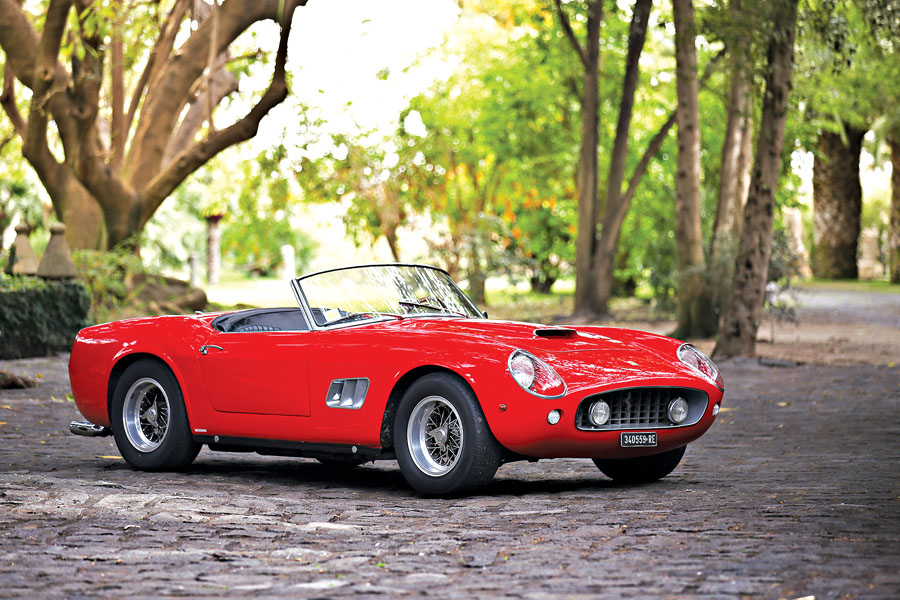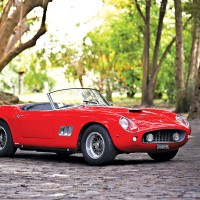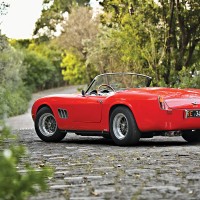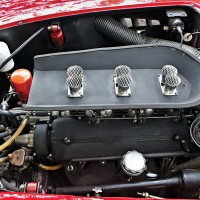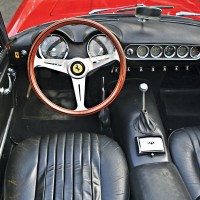SCM Analysis
Detailing
| Vehicle: | 1961 Ferrari 250 GT SWB California Spyder |
| Years Produced: | 1960–63 |
| Number Produced: | 56 |
| Original List Price: | $12,000 |
| SCM Valuation: | Median to date, $16,005,000; high sale, $18,644,874 |
| Tune Up Cost: | $3,500 |
| Distributor Caps: | $550 |
| Chassis Number Location: | Left frame member by steering box |
| Engine Number Location: | Right rear motor mount |
| Club Info: | Ferrari Club of America |
| Website: | http://www.ferrariclubofamerica.com |
| Alternatives: | 1961 Ferrari 250 GT SWB, 1938 Bugatti Type 57 Atalante coupe, 1934 Alfa Romeo 8C 2300 long chassis, 1955 Jaguar D-type |
| Investment Grade: | A |
This car, Lot 69, sold for $17,160,000, including buyer’s premium, at Gooding & Company’s Amelia Island, FL, auction on March 11, 2016.
Ferrari’s production model lineup for 1961 included the recently introduced 250 GT SWB Berlinetta, the 4-passenger 250 GTE 2+2, the open-top 250 GT Pininfarina Cabriolet Series II, the 250 GT SWB California and the ultra-high-end 400 Superamerica coupe and cabriolet. This was an exciting group of cars — and all but one model currently sells for more than a million dollars.
The SWB California was introduced in 1960 to update the previous 250 LWB California. The LWB California was a sister to the 250 Tour de France, a dual-purpose berlinetta named after its success in the famous race. Both were built on a 2,600-mm wheelbase chassis and featured a 3-liter V12 engine.
The California was designed for the American market, and in particular, for the temperate climate of its namesake state. It was nearly an open-top version of a dual-purpose race car. The early LWB examples were a bit on the primitive side, with ill-fitting tops, uncomfortable seating, flexible chassis, marginal brakes and just-good-enough bodywork.
George Arents, who was one of Luigi Chinetti’s backers in the North American Racing Team (NART), went so far as to write Stan Nowak a letter for Nowak’s Ferrari California book, noting, “Next to the 500 TRC and the 6-cylinder inline racing cars, the type California was the worst car to ever wear the Ferrari badge.”
NYC commuting really wasn’t the purpose that a California was designed for, so Mr. Arents’ opinion should be taken lightly.
A better Spyder
The SWB California addressed some of the issues of the early version. The chassis was shortened by 200 mm (about eight inches) to 2,400 mm, which decreased flex and improved handling. Other mechanical updates included a switch from an inside- to an outside-plug engine and a switch from drum to disc brakes.
Spotters will notice a lower bodyline on SWB Californias compared with the LWB. The SWB also has a depression in the hood forward of the scoop that the LWB does not. The vent in the front fender of the SWB has two fins, and the LWB has three fins.
The late SWB models featured more comfortable seating, wool carpeting and a leather-covered dash. Ferrari updates are evolutionary, and noted updates do not necessarily coincide exactly with the wheelbase switch.
In very expensive company
There have been four notable sales of SWB Californias during the past couple years.
Gooding’s sale of 2871GT for $17,160,000 this year was the top sale of the Amelia weekend and the 11th-highest auction sale on SCM’s “Million-Dollar Sales” list. Ironically, that sale nudged Gooding’s 2015 $16.8 million sale of 3095GT from number 11 to number 12 on SCM’s list. Even more impressive, Gooding’s sale of 2903GT in 2014 for $15.1 million ranked ninth on the SCM list but has since fallen to 15th.
Artcurial’s 2015 sale of the Baillon “barn find” SWB California was the highest known sale of a California. The $18.6 million sale of 2935GT holds number 8 on SCM’s list and is truly staggering when put in context.
You may remember the Baillon California from the sensational pictures of it in the corner of a garage covered with so many boxes that it dented the trunk lid.
While it was a barn find, 2935GT was a paradox. It may have been as little as 15 years old when retired, but a previous owner had driven the car hard. There were areas of specimen originality, but there also was decay as well as modifications from its delivered configuration.
A serious debate continues on whether 2935GT should be preserved or restored.
Better — but cheaper — than the Baillon car
The buyer of the Baillon 2935GT showed the car at Pebble Beach last year and at Cavallino this year. The attention it garnered was far greater than the best restored car on the field. If attention was his goal, he got his money’s worth.
Our subject car, 2871GT, is a good car in impressive condition. It should have been worth more than the Baillon car, but the market said otherwise.
Californias are must-have cars for serious Ferrari collections. Rather than being the only Ferrari in the garage, a California is more likely to be found in a room full of Ferraris. Indeed, the same owner of 2871GT also bought a 250 SWB berlinetta not long ago. The same buyer dropped $4.4 million on another Ferrari at Amelia Island before taking his private jet back across the pond.
Gooding’s estimate on 2871GT was $15,000,000 to $17,000,000. The final sale just nipped the high end of the estimate. This might have been Monopoly money for the buyer, but it was a lottery win for the seller. The car was purchased in 1985 — when the value would have been in the hundreds of thousands of dollars.
This car turned out to be an investment of a lifetime for the seller, so the win has to go to him. ♦
(Introductory description courtesy of Gooding & Company.)
